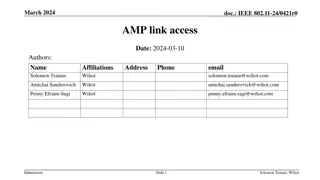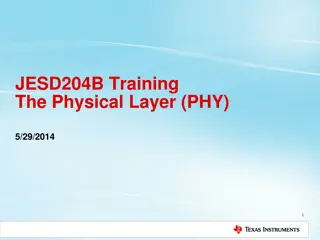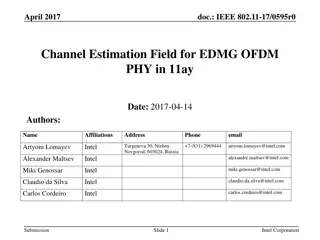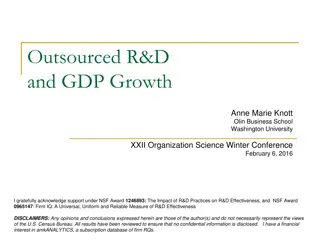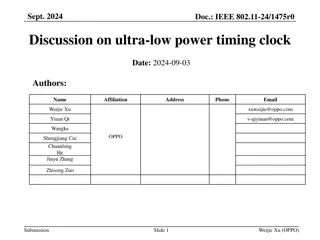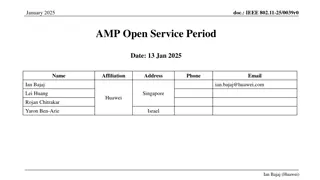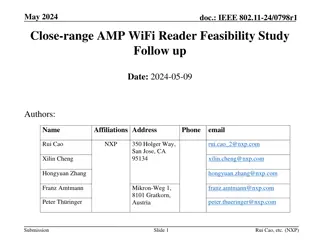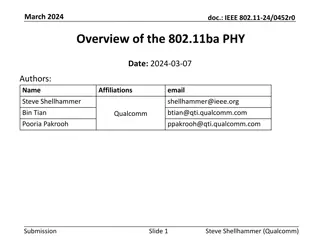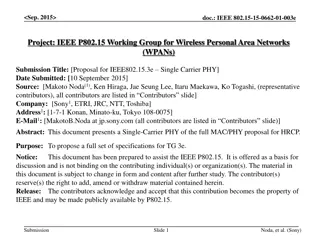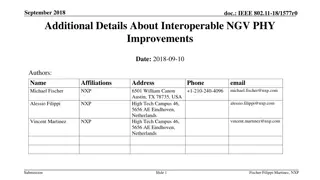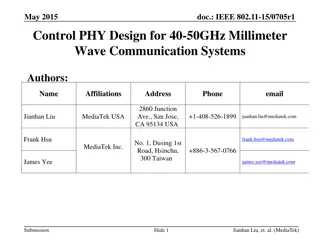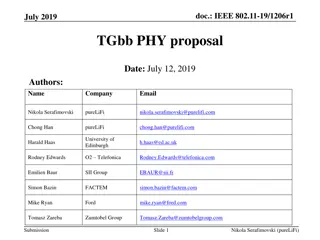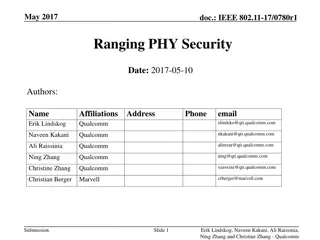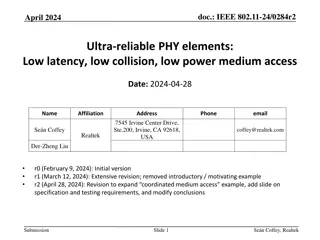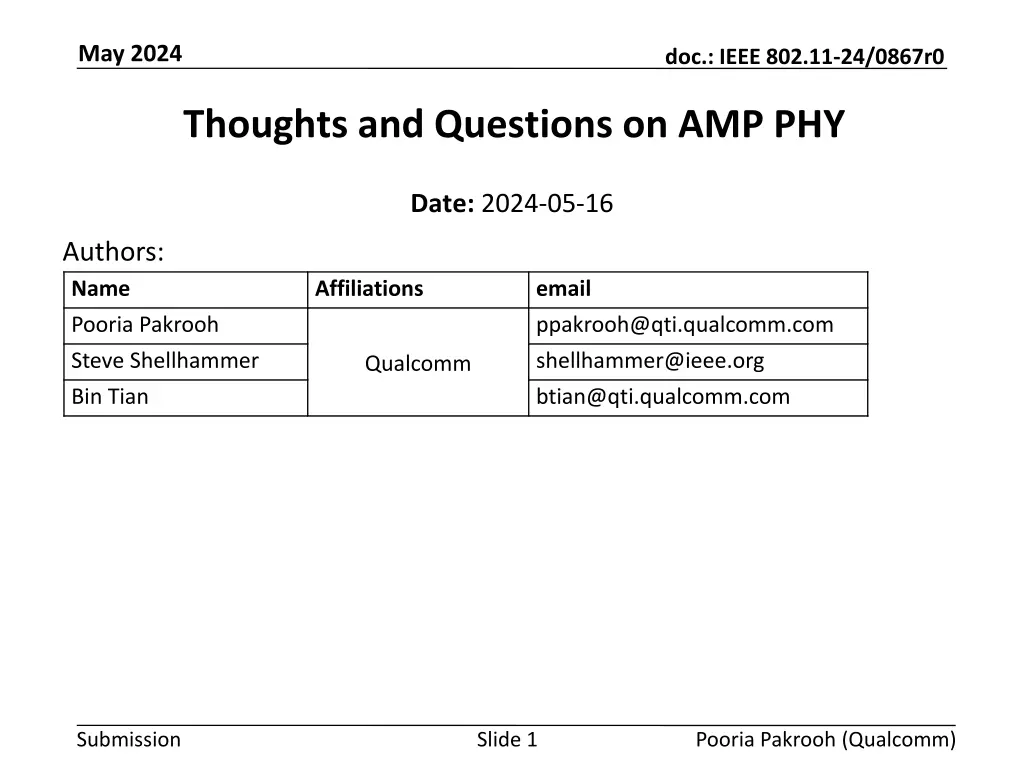
Understanding IEEE 802.11-24/0867r0 AMP PHY Terminology and Link Budget
Explore IEEE 802.11-24/0867r0 document discussing AMP PHY terminology, energy integration, separate energizer setups, and link budget considerations. Learn about AMP AP, AMP STA, and how wireless communication links align with the Energizer link budget.
Download Presentation

Please find below an Image/Link to download the presentation.
The content on the website is provided AS IS for your information and personal use only. It may not be sold, licensed, or shared on other websites without obtaining consent from the author. If you encounter any issues during the download, it is possible that the publisher has removed the file from their server.
You are allowed to download the files provided on this website for personal or commercial use, subject to the condition that they are used lawfully. All files are the property of their respective owners.
The content on the website is provided AS IS for your information and personal use only. It may not be sold, licensed, or shared on other websites without obtaining consent from the author.
E N D
Presentation Transcript
May 2024 doc.: IEEE 802.11-24/0867r0 Thoughts and Questions on AMP PHY Date: 2024-05-16 Authors: Name Affiliations email Pooria Pakrooh ppakrooh@qti.qualcomm.com Steve Shellhammer Bin Tian shellhammer@ieee.org btian@qti.qualcomm.com Qualcomm Submission Slide 1 Pooria Pakrooh (Qualcomm)
May 2024 doc.: IEEE 802.11-24/0867r0 Introduction Here we make some high-level comments on the AMP Downlink (DL) and Uplink (UL) PHYs And we ask some question to the Task Group regarding the DL and UL PHYs Submission Slide 2 Pooria Pakrooh (Qualcomm)
May 2024 doc.: IEEE 802.11-24/0867r0 Outline Terminology Energizer Location Link Budget Possible AMP PHY Modes Signal Bandwidth o Sub-1GHz and 2.4 GHz Clock Accuracy Backscatter Downlink Waveform Conclusions Submission Slide 3 Pooria Pakrooh (Qualcomm)
May 2024 doc.: IEEE 802.11-24/0867r0 Terminology (Used Here) AMP STA o This is often referred to as the AMP Tag o Here we will call it the AMP STA to be consistent with IEEE 802.11 terminology AMP AP o This is the device that can read the AMP STA o In some cases, this might be thought of as the AMP Reader o This may be a physical AP or a mobile soft AP AMP Downlink (DL) o The transmission from the AMP AP to the AMP STA o This may also be called the wake-up radio (WUR) AMP Uplink (UL) o The transmission from the AMP STA to the AMP AP Note: More discussion on terminology will be likely be needed Submission Slide 4 Pooria Pakrooh (Qualcomm)
May 2024 doc.: IEEE 802.11-24/0867r0 Integrated Energizer Here the AMP AP integrates o Energizer o Downlink Transmitter o Uplink Receiver The wireless communication links only need to meet the Energizer link budget AMP AP AMP STA Submission Slide 5 Pooria Pakrooh (Qualcomm)
May 2024 doc.: IEEE 802.11-24/0867r0 Separate Energizer AMP AP AMP Energizer AMP STA Here we have two separate devices to access the AMP STA o AMP AP (DL TX and UL RX) and a Separate AMP Energizer o This also includes the case where the energy source is different than RF (e.g., solar or thermal) The wireless links are no longer constrained by the Energizer link budget Submission Slide 6 Pooria Pakrooh (Qualcomm)
May 2024 doc.: IEEE 802.11-24/0867r0 Link Budget Integrated Energizer o The Energizer link budget depends on the Energizer TX power and the required power level to harvest that energy at the AMP STA o As an example, if the TX power is 30 dBm and the required RX power to harvest energy is -25 dBm, then the Energizer Link is limited to around 55 dB o The DL/UL wireless links only need to meet the Energizer Link Budget or 8.5 dB more if operating in 2.4 GHz Path Loss in 2.4 GHz is approximately 8.5 dB higher than in sub-1 GHz Separate Energizer o If the AMP AP is separate from the Energizer, then the DL/UL Link Budgets are not limited by the Energizer Link Budget o Then the DL/UL Link Budgets can be much larger For example, depending on the AMP STA capabilities, the DL/UL Link Budgets could be 100 dB or more. o One possibility in this case, the DL could be handled using 802.11ba and the UL could be handled using 802.11b/n Submission Slide 7 Pooria Pakrooh (Qualcomm)
May 2024 doc.: IEEE 802.11-24/0867r0 Possible PHY Modes There are many possible PHY Modes that could be specified in 802.11bp o AMP RF Energizer o AMP Downlink/WUR o AMP Active Uplink o AMP Backscatter There are also different frequency bands to consider o 2.4 GHz o Sub-1 GHz It is important to understand which combinations are to be specified by the Task Group Submission Slide 8 Pooria Pakrooh (Qualcomm)
May 2024 doc.: IEEE 802.11-24/0867r0 Possible PHY Modes PHY Mode 2.4 GHz Sub-1 GHz AMP RF Energizer N/A AMP Downlink/WUR ? AMP Active Uplink ? AMP Backscatter ? We would like to hear feedback from the Task Group on who is interested in developing these various PHY Modes Should the 802.11bp DL/WUR focus on the Integrated Energizer case, at (high /mid) SNR? Submission Slide 9 Pooria Pakrooh (Qualcomm)
May 2024 doc.: IEEE 802.11-24/0867r0 Signal Bandwidth (2.4 GHz) The 802.11ba WUR Portion Bandwidth is 4 MHz [1, 2] From [3] we know that the 2.4 GHz Regulations are: ? (dBm) Region Power Limit for AP (dBm) PSD Limit for AP (dBm/MHz) 20 MHz 802.11 Limit (dBm) 4 MHz WUR Limit (dBm) FCC 30 N/A 30 30 0 ETSI 20 10 20 16 -4 China 20 10 20 16 -4 There maybe some value in increasing above 4 MHz There are no TX power benefits going beyond 10 MHz Submission Slide 10 Pooria Pakrooh (Qualcomm)
May 2024 doc.: IEEE 802.11-24/0867r0 Signal Bandwidth (sub-1 GHz) In the TIG Report [4] the bandwidths listed, based on regulations in the sub-1 GHz, range from 200 kHz to 1 MHz It also mentions that several sub-1 GHz signal bandwidths could be supported There are two possible ways of addressing this topics 1. Support 200 kHz Only 2. Support Multiple sub-1 GHz Bandwidths Question to the Task Group o Should multiple sub-1 GHz bandwidth be supported or just one? Which sub-1 GHz frequency bands should be supported? o Communication bands (e.g., like 802.11ah)? o RFID bands? Submission Slide 11 Pooria Pakrooh (Qualcomm)
May 2024 doc.: IEEE 802.11-24/0867r0 Clock Accuracy In [5] it was proposed that the AMP STA PHY clock accuracy be set at ???? PPM, to allow for a very low power AMP STA It was also proposed that the AMP Sleep clock accuracy be set at ??,??? PPM, to allow for a very low power sleep mode Does the Task Group agree that those are the correct clock accuracy values? Submission Slide 12 Pooria Pakrooh (Qualcomm)
May 2024 doc.: IEEE 802.11-24/0867r0 Backscatter Downlink Waveform For cases where the uplink is generated by backscattering a downlink waveform, the Task Group needs to specify the downlink waveform to be back scattered What downlink waveform should be used in 2.4 GHz to enable the backscatter uplink? o Should it be the same bandwidth as the AMP Downlink, to meet regulatory requirements? In the sub-1 GHz should a single carrier DL backscatter waveform be used, due to the narrowband channels? o Or maybe some other waveform? Submission Slide 13 Pooria Pakrooh (Qualcomm)
May 2024 doc.: IEEE 802.11-24/0867r0 Conclusions Here we have provided some initial thoughts on the AMP PHY for both 2.4 GHz and sub-1 GHz We have raised some questions for the Task Group to consider and discuss This will likely result in additional questions we will need to discuss and address Submission Slide 14 Pooria Pakrooh (Qualcomm)
May 2024 doc.: IEEE 802.11-24/0867r0 References 1. IEEE Std 802.11ba, IEEE Standard for Local and Metropolitan Area Networks: Wireless LAN Medium Access Control (MAC) and Physical Layer (PHY) Specifications. Amendment: Wake-up Radio Operation, 2021 2. Steve Shellhammer, Alfred Asterjadhi, and Yanjun Sun, IEEE 802.11ba: Ultra-Low Power Wake-up Radio Standard, Wiley-IEEE Press, 2023 3. Steve Shellhammer and Bin Tian, Regulations and Noise Figure Impact on SNR, IEEE 802.11-17/365r0, March 2017 4. Weijie Xu, et. al., Technical Report on support of AMP IoT devices in WLAN, IEEE 802.11-23/2203r1, November 2023 5. Amichai Sanderovich, Sagi Kupferman, Yuval Amran, Considerations for AMP Devices, IEEE 802.11-23/1140r0, July 2023 Submission Slide 15 Pooria Pakrooh (Qualcomm)


